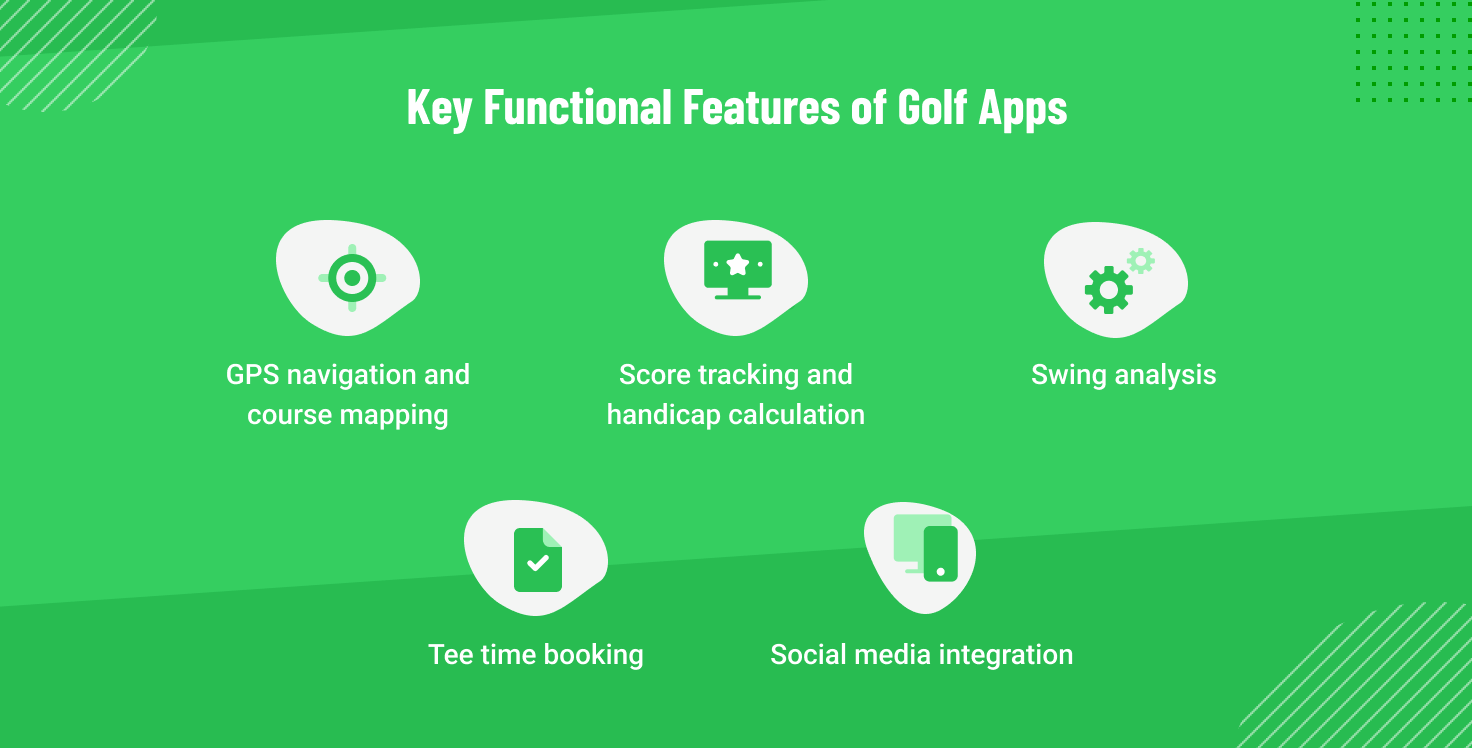Level Up Your Game: The What, Why & How of Golf Apps
Table of contents
- Golf App Development Lifecycle
- Key Functional Features of Golf Apps
- Benefits of Using Mobile Apps for Golf
- Benefits for golf players
- Increased accuracy and improved game management
- Enhanced performance analysis
- Convenience and accessibility
- Tools for game improvement
- Increased enjoyment and engagement
- Benefits for golf clubs
- Optimized operations
- Enhanced customer engagement and loyalty
- Increased revenue opportunities
- Improved data collection and analysis
- Strengthened brand presence
- Overview of Popular and Successful Golf Apps
- GPS and score tracking apps
- Swing analysis apps
- Social golf apps
- Tee time booking apps
- Technology Stack of Golf Apps
- Mobile development frameworks
- GPS and geolocation technologies
- Data processing and databases
- Machine learning and AI
- API integration
- Wearable device integration
- Market Dynamics and Future Trajectory of Golf Apps
- Comparison of Approaches to Golf App Development
- Native apps
- Hybrid apps
- Web apps
- Potential Challenges and Risks in Developing and Implementing Golf Apps
- Conclusion and Strategic Recommendations
- Strategic recommendations for app developers
- Strategic recommendations for golf clubs
In today's world, technology plays an increasingly significant role in various aspects of life, and sport is no exception. Golf, traditionally considered a conservative sport, is also undergoing digital transformation. There is a noticeable shift from traditional methods to digital solutions designed to enhance the golfing experience and optimize golf club management. Mobile devices have become integral to everyday life, and users increasingly expect services and information to be readily available through applications.
In the context of golf, mobile apps are becoming increasingly in demand among players seeking to improve their game, navigate the course, and interact with other golf enthusiasts, as well as among golf clubs that see them as a tool to enhance operational efficiency, customer engagement, and revenue growth. These apps offer various functions, from GPS navigation, score tracking, swing analysis, and tee time booking. We decided to analyze the most popular golf apps, including their development stages, key functionalities, and benefits for players and golf clubs, and provide a review of technologies used, market trends and future forecasts, a comparison of various development approaches, and an assessment of potential challenges and risks.
This article aims to provide a complete understanding of the golf app landscape, identify key trends and opportunities, and offer strategic recommendations for businesses and individuals involved in this field. We tried to cover the entire lifecycle of these apps, from development to market trends and prospects.
Golf App Development Lifecycle
Developing a mobile app for golf involves several key stages that must be carefully planned and executed to create a successful and in-demand product. Understanding these stages is crucial for all stakeholders, from investors to developers and golf club owners.
The mobile app development process, in general, includes the following main stages:
- Strategy/idea/definition: The first stage involves defining the application's purpose, identifying the target audience, and formulating business goals. Market research, competitor analysis, and the definition of the main tasks that the app should support or solve are conducted at this stage. Another important aspect is choosing the right platform (iOS, Android, or both) and the monetization method.
- Planning/analysis and planning/requirements gathering: This stage defines the project scope, selects platforms, details the app's functions, and creates a product roadmap. Functional and non-functional requirements for the app are also determined.
- Design (UI/UX): The design stage involves creating mockups, prototypes, and the app's visual interface, focusing on usability and user experience. Ensuring an intuitive and appealing design is crucial. An information architecture is developed, defining the data structure and user interaction with the app.
- Development: The development stage involves creating the app's server-side and client-side components, including integrating necessary APIs and third-party services. This stage also includes developing the app's internal logic (backend) and user interface (front end).
- Testing/quality assurance: The app is thoroughly tested for errors, performance issues, and usability on various devices and operating systems. Testing includes verifying the app's compliance with the initial requirements and user expectations.
- Deployment/publication: After successful testing, the app is published in app stores (Apple App Store and Google Play Store), and promotional materials are prepared for its marketing.
- Support and maintenance/post-development: After the app's launch, its performance is monitored, errors are fixed, functions are updated, and user feedback is collected for further improvement. This continuous stage aims to maintain the app's relevance and competitiveness.
For the golf app development, it is necessary to consider several specific aspects:
- Accuracy of GPS data: High accuracy in location determination is crucial for course navigation features.
- Integration with golf-specific APIs: Integration with APIs for handicap calculation, tee time booking, and course information retrieval may be required.
- Usability in outdoor environments: The app's interface should be easily readable in bright sunlight and have significant control elements.
- Consideration of golf game nuances: Development must consider various aspects of the game, such as scoring, statistics tracking, and golf rules.
The mobile app development process is iterative and requires constant feedback and adaptation, especially in a dynamic field like golf, where user needs and technological capabilities constantly evolve. Accuracy and reliability are paramount in golf apps, especially for features like GPS and scoring. This requires meticulous testing and potentially specialized knowledge in areas such as geolocation.
Key Functional Features of Golf Apps
Golf apps offer many features to enhance the playing experience and provide valuable tools for players and golf clubs. These features can be divided into several main categories.

- GPS navigation and course mapping: One key function is providing accurate distances to the green, hazards, and other points on the course. Many apps offer 2D and 3D course maps, aerial photography, and even augmented reality. Some apps, like the Motocaddy GPS App, use an extensive database of GPS-enabled golf courses worldwide and provide information on distances to key points and hazards.
- Score tracking and handicap calculation: Apps allow players to record their scores, track statistics (fairway hits, green hits, number of putts, etc.), and automatically calculate their handicap. Some apps integrate with official handicap systems, such as USGA GHIN. TheGrint, for example, allows you to link a USGA Handicap Index® account and instantly synchronize scores.
- Swing analysis: Many apps offer features for recording and analyzing a player's swing, including slow-motion playback, drawing tools, comparison with professional swings, and integration with sensors or artificial intelligence. Apps like Swing Profile and V1 Golf provide advanced swing analysis tools and access to training video libraries.
- Tee time booking: Some applications allow players to search for and book tee times at various golf courses, often with the ability to search for available times, book for multiple players, and receive discounts. GolfNow is an example of an app that allows you to book tee times at thousands of golf courses worldwide.
- Social media integration: Many apps offer social features, allowing players to connect with friends, share scores, participate in leaderboards, create groups, and organize friendly competitions. Apps like 18Birdies and GolfLync emphasize social functions and connect golf enthusiasts.
- Additional features: Besides the core features, many apps offer a range of extra functions, such as in-app purchases, wearable device integration, personalized training plans, tournament management, food and beverage ordering, and golf rules guides. The GHIN Mobile App, for example, offers advanced GPS features such as a shot heat map and putt break map.
There is a trend towards creating universal golf apps that combine many functions and provide a comprehensive tool for players on and off the course. Personalization and customization are becoming increasingly important, with apps offering features tailored to individual golfers' skill levels, preferences, and playing habits.
Benefits of Using Mobile Apps for Golf
Golf apps significantly benefit individual players and golf clubs, contributing to an enhanced playing experience and optimized operational efficiency.
Benefits for golf players
Increased accuracy and improved game management
Accurate GPS data on distances to various points on the course helps players make more informed decisions when choosing clubs and planning shots.
Enhanced performance analysis
Tracking scores, statistics, and swing data allows players to identify their strengths and weaknesses, facilitating more focused training.
Convenience and accessibility
Easy access to course information, tee time booking, scorekeeping, and social interaction through a single app.
Tools for game improvement
Swing analysis features, personalized tips, and club selection recommendations help players refine their technique and make more effective decisions.
Increased enjoyment and engagement
Social features, leaderboards, and an overall improved playing experience can make golf more enjoyable and engaging.
Benefits for golf clubs
Optimized operations
Efficient tee time booking and schedule management, reducing the workload on staff.
Enhanced customer engagement and loyalty
Direct communication via push notifications, personalized offers, loyalty programs, and community building.
Increased revenue opportunities
Convenient online booking, pro shop purchases, food and beverage orders, event registration, and targeted promotions.
Improved data collection and analysis
Gathering valuable data on player behavior, preferences, and app usage for more informed decision-making.
Strengthened brand presence
Custom-branded apps enhance brand recognition and create a modern, tech-savvy image.
Mobile apps transform golf clubs from simple places to play into interactive digital ecosystems, fostering stronger connections with members and customers. Collecting and analyzing user data through mobile apps provides golf clubs with unprecedented opportunities for targeted marketing, personalized services, and continuous improvement of their offerings.
Overview of Popular and Successful Golf Apps
The market offers a wide variety of mobile golf apps, each with unique features tailored to specific user needs. Examining some popular and successful examples can provide insight into the main trends and key features demanded by players.

Apps can be broadly divided into several categories depending on their primary functionality:
GPS and score tracking apps
- Hole19: A popular app with GPS navigation for over 42,000 courses, score tracking, and smartwatch connectivity.
- Golfshot: A comprehensive app with accurate GPS distances, detailed statistics, 3D course maps, and an augmented reality feature.
- TheGrint: An application with a GPS rangefinder, USGA handicap tracking, detailed statistics, and social features. Users highlight the convenience of statistical analysis and the ability to create leaderboards for playing with friends.
- GolfLogix: An app known for its GPS accuracy, detailed green maps, and statistics tracking. Users highly rate the accuracy of the distance to the pin and the putt break view feature.
- SwingU: An app with GPS, score tracking, and game analysis, including shot analysis considering wind and elevation, as well as club recommendations.
- Golf Pad: A free application with a GPS rangefinder, digital scorecard, and shot-tracking capabilities.
Swing analysis apps
- Swing Profile: An app that automatically records and replays a golfer's swing, offering tools for analysis and comparison with professional players. Users note the high degree of automation in swing capture and analysis.
- V1 Golf: An app for recording, analyzing, and comparing swings with professionals, offering an extensive library of training videos. Users note the improved video quality in recent updates, which allows for more accurate swing analysis.
- GOLFTEC App: An app that allows you to record your swing with automatic centering and trimming, slow-motion playback, a skeleton feature, and club tracing.
Social golf apps
- 18Birdies: An application with GPS, score tracking, social features for connecting with other players, and the ability to organize competitions.
- All Square Golf: A social network for golfers, allowing users to find courses, connect with other players, and share experiences.
- GolfLync: A platform for golfers to connect, find playing partners, and organize tee times. Users note the user-friendly interface and the social aspect of the app.
- Wedoo.Golf: A social golf app that organizes friendly competitions and communication between players.
Tee time booking apps
- GolfNow: One of the most popular apps for finding and booking tee times at thousands of courses worldwide, often offering special deals. Users note the convenience of booking and the availability of "hot deals," but some express dissatisfaction with the bonus usage policy.
- TeeOff: Another app from GolfNow for booking tee times.
The diversity of apps on the market indicates that each often specializes in a specific aspect of the game or offers a unique set of features to meet various user needs and preferences. User reviews and ratings are essential indicators of an app's success and often highlight the importance of accuracy, ease of use, and a comprehensive feature set.
Technology Stack of Golf Apps
Golf app development requires the use of various technologies to ensure functionality and performance. Choosing the right technology stack is crucial for the app's success.
Mobile development frameworks
Golf apps are typically developed using native programming languages, such as Swift for iOS and Kotlin for Android, which ensures high performance. Cross-platform development, which allows using a single codebase for both platforms, often uses frameworks such as React Native, Flutter, or Xamarin.
GPS and geolocation technologies
GPS APIs determine the user's location, measure distances, and map courses.
Data processing and databases
Cloud services such as AWS, Microsoft Azure, and Google Cloud, store and manage large volumes of data. PostgreSQL, MySQL, and MongoDB can be used as databases.
Machine learning and AI
AI technologies are used for swing analysis, shot prediction, personalized recommendations, and real-time score updates. For example, the GOLFTEC app uses AI to measure swings in 3D and provides detailed analysis.
API integration
Integration with third-party services is essential in implementing payment gateways (Stripe, PayPal), social networks, and golf club management systems.
Wearable device integration
Integration with smartwatches and fitness trackers via Bluetooth and other protocols provides data on the course and tracks physical activity.
The technology stack for golf apps is becoming increasingly complex. It utilizes advances in artificial intelligence, cloud computing, and wearable device integration to provide a richer and more personalized user experience. The choice between native and cross-platform development depends on various factors, including desired performance, budget, and timeline, with each approach having its own advantages and disadvantages.
Market Dynamics and Future Trajectory of Golf Apps
The market for golf apps is demonstrating steady growth, driven by the increasing popularity of golf and the rising number of smartphone users. The future development of this market is expected to be influenced by several key trends.
- Personalized experience: There is a trend toward creating apps that offer personalized recommendations based on a player's skill level, preferences, and history of previous rounds. The use of artificial intelligence for swing analysis and providing individualized advice will become increasingly common.
- Integration with wearable devices and smart gadgets: Deeper integration with smartwatches, fitness trackers, and other golf gadgets will allow players to receive real-time data directly on their wrists.
- Expansion of social features: Social features will become more interactive and engaging, including the ability to participate in virtual tournaments, create communities of interest, and share experiences with other players.
- Focus on game improvement: Apps will offer increasingly sophisticated tools for game analysis, including advanced statistics, AI-powered swing analysis, and integration with professional coaches.
- Monetization strategies: Developers will continue experimenting with various monetization models, including in-app purchases, subscriptions, advertising, and data monetization.
In the future, wider adoption of augmented and virtual reality technologies is expected to create immersive training environments and enhance data visualization on the course. Further development of artificial intelligence will enable the creation of even more accurate and personalized game analysis and training tools. Mobile apps for golf will be increasingly integrated into the broader golf ecosystem, including equipment, courses, and coaching services.
The future of mobile golf apps will likely be defined by hyper-personalization, seamless integration with other technologies, and a growing emphasis on using data and artificial intelligence to help golfers improve their game and enjoy the sport more. Monetization strategies must evolve to balance revenue generation with user satisfaction, perhaps focusing on value-added features and personalized services rather than intrusive advertising.
Comparison of Approaches to Golf App Development
Developing mobile golf apps involves several approaches, each with advantages and disadvantages. The main approaches are native, hybrid, and web app development.
Native apps
These are developed specifically for a particular mobile operating system (iOS or Android) using the corresponding programming languages (Swift or Objective-C for iOS and Kotlin or Java for Android) and development tools.
- Advantages: Provide high performance, full access to device features (e.g., GPS, camera), the best user experience, and more reliable operation.
- Disadvantages: Require higher development time and costs, as separate apps need to be created for each platform.
- Best scenarios for golf applications: Apps that require high performance, intensive use of GPS (e.g., course navigation, shot tracking), and deep integration with device functions (e.g., swing analysis using the camera).
Hybrid apps
These are developed using web technologies (HTML, CSS, JavaScript) and cross-platform frameworks such as React Native, Flutter, or Ionic.
- Advantages: Allow the use of a single codebase for multiple platforms, which reduces costs and speeds up the development process.
- Disadvantages: May have some performance limitations compared to native apps and do not always provide the same level of access to all device features.
- Best scenarios for golf apps: Applications where development speed and reaching a broad audience on both platforms are essential, and performance requirements are not critical.
Web apps
These are websites optimized for viewing on mobile devices through a browser.
- Advantages: Easily accessible through any browser, not requiring installation, easier to update.
- Disadvantages: Limited access to device features, often requiring a constant internet connection, may be less user-friendly than native apps.
- Best scenarios for golf apps: Apps with basic functionality, such as viewing golf club information or booking tee times through a web interface.
The choice of development approach is a strategic decision that should be based on a careful assessment of the project's specific needs and constraints. No single approach is universally the best.
|
Approach |
Advantages |
Disadvantages |
Best scenarios for golf apps |
|
Native |
High performance, full access to device features, best UX |
High development cost, separate code for each platform |
Apps that require high performance, intensive GPS usage, and deep integration with device functions. |
|
Hybrid |
Single codebase, faster development, lower costs |
Potential performance limitations, dependency on frameworks |
Apps where development speed and reaching a broad audience are important, and performance requirements are not critical. |
|
Web |
Easy accessibility, no installation required, simple updates |
Limited access to device features, internet connection often required |
Apps with basic functionality, such as viewing club information and booking through a web interface. |
Potential Challenges and Risks in Developing and Implementing Golf Apps
The development and implementation of mobile apps for golf involves several potential challenges and risks that must be considered to ensure the project's success.

- Accuracy and reliability of data: Ensuring the high accuracy of GPS data, distance measurements, and swing analysis is critical, especially given the variety of devices and playing conditions.
- Integration with various systems and devices: Integrating with different golf club management systems, wearable devices, and third-party APIs can be a complex challenge.
- UI/UX: It is of paramount importance to create an intuitive and user-friendly interface, especially for use on the course during play.
- Security and privacy: Protecting user data and financial transactions (such as bookings or in-app purchases) requires the implementation of robust security measures.
- Scalability: The app must handle a growing number of users and increasing volumes of data, especially for apps with analytics features.
- Development costs and timelines: Development costs and timelines may exceed initial estimates, especially when implementing complex functions.
- Competition: The market for golf apps is saturated, and standing out among the many existing offerings can be challenging.
Overcoming challenges related to data accuracy, seamless integration, and creating an engaging user experience is crucial for the success of any golf app. A well-thought-out strategy that considers security, scalability, and cost is necessary to mitigate the risks of developing and deploying golf mobile apps.
Conclusion and Strategic Recommendations
Mobile golf apps have become an integral part of the modern golf industry, providing valuable tools for players and golf clubs. From precise course navigation and detailed score tracking to swing analysis and convenient tee time booking, these apps significantly enhance the playing experience and streamline golf club operations. The market continues to grow and evolve, driven by technological innovations and increasing user expectations for personalized and convenient digital solutions.
Strategic recommendations for app developers
- Focus on providing high accuracy and reliability, especially for core features like GPS and scorekeeping.
- Prioritize user experience and intuitive design for ease of use during play.
- Carefully weigh the pros and cons of native versus hybrid development based on project goals.
- Explore personalization options and integration with emerging technologies like artificial intelligence and wearable devices.
- Develop robust security measures to protect user data and financial transactions.
- Implement scalable architectures to ensure future growth potential.
Strategic recommendations for golf clubs
- Invest in custom-branded mobile apps to enhance customer engagement and brand loyalty.
- Integrate booking, communication, and payment features to provide a seamless user experience.
- Utilize push notifications and personalized offers to increase revenue and event participation.
- Apply data analytics to understand player behavior and improve service offerings.
- Ensure proper maintenance and regular updating of the app with current information.
The mobile golf app market presents significant opportunities for both developers and golf clubs that can effectively leverage technology to improve the golfing experience and optimize their operations.
Published on Jun 1, 2025





